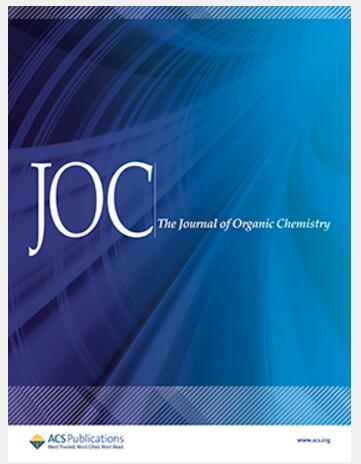高效非掺杂oled中2,5-取代d - a型硅孔的苯基间隔调制。
IF 3.3
2区 化学
Q1 CHEMISTRY, ORGANIC
引用次数: 0
摘要
具有平面结构的有机荧光团应用于有机发光二极管(oled)中,有利于π-π聚集体堆叠,导致低光致发光量子产率(PLQYs)。将分子转子(如苯基)掺入荧光团(如硅溶胶)的外围,可以防止π-π在聚集体中堆叠,从而最大限度地减少荧光猝灭。在本研究中,我们在四苯基硅酮的2位和5位上引入电子供体(D)单元(9,9-二甲基吖啶和苯恶嗪)形成D-A型分子,其中四苯基硅酮单元作为电子受体(A)。与D- a型硅孔的分子设计相比,通过在D和a单元之间添加苯基间隔基团进行进一步修饰,得到的D- ph - a型硅孔分子(silole -Ph-AC和silole -Ph-PXZ,其中Ph-AC为10-联苯-9,9-二甲吖啶,Ph-PXZ为n -联苯-苯氧嗪)更扭曲,更不容易发生π-π堆叠分子结构,从而改善了光物理性能,如蓝移发射,更高的荧光效率。当它们应用于非掺杂oled时,具有更好的外量子效率(EQE)。其中silole - ph - ac基OLED EQEmax最佳,为5.52%。本文章由计算机程序翻译,如有差异,请以英文原文为准。
Phenyl Spacer Modulation of 2,5-Substituted D-A-Type Siloles for Efficient Nondoped OLEDs.
Organic fluorophores with planar structures applied in organic light-emitting diodes (OLEDs) favor π-π stacking in aggregates, resulting in low photoluminescence quantum yields (PLQYs). Incorporation of molecular rotors such as phenyls on the periphery of fluorophores such as silole can prevent π-π stacking in aggregates to minimize fluorescence quenching. In this study, we introduced electron-donor (D) units (9,9-dimethylacridine and phenoxazine) at the positions 2 and 5 of tetraphenylsilole to form D-A-type molecules, in which the tetraphenylsilole unit acts as an electron acceptor (A). Compared to the molecular design of D-A-type siloles, further modification via the addition of a phenyl spacer group between D and A units leads to the resulting D-Ph-A-type silole molecules (Silole-Ph-AC and Silole-Ph-PXZ, where Ph-AC is 10-biphenyl-9,9-dimethylacridine and Ph-PXZ is N-biphenylphenoxazine) being more twisted and less prone to π-π stacking molecular structures, resulting in improved photophysical properties such as a blue-shifted emission, a higher fluorescence efficiency, and a better external quantum efficiency (EQE) when they are applied in nondoped OLEDs. Among them, the Silole-Ph-AC-based OLED exhibits the best EQEmax of 5.52%.
求助全文
通过发布文献求助,成功后即可免费获取论文全文。
去求助
来源期刊

Journal of Organic Chemistry
化学-有机化学
CiteScore
6.20
自引率
11.10%
发文量
1467
审稿时长
2 months
期刊介绍:
Journal of Organic Chemistry welcomes original contributions of fundamental research in all branches of the theory and practice of organic chemistry. In selecting manuscripts for publication, the editors place emphasis on the quality and novelty of the work, as well as the breadth of interest to the organic chemistry community.
 求助内容:
求助内容: 应助结果提醒方式:
应助结果提醒方式:


